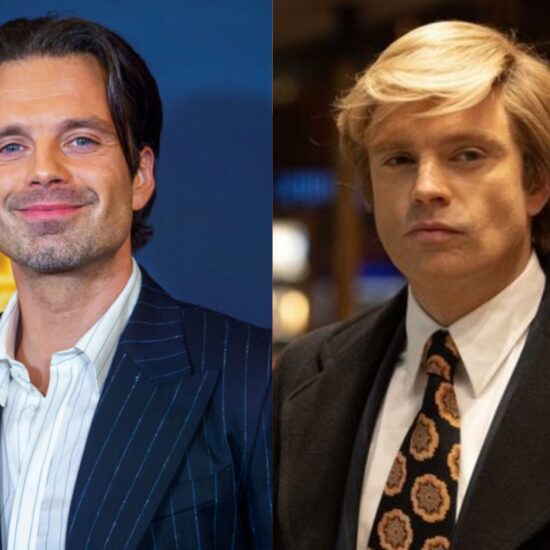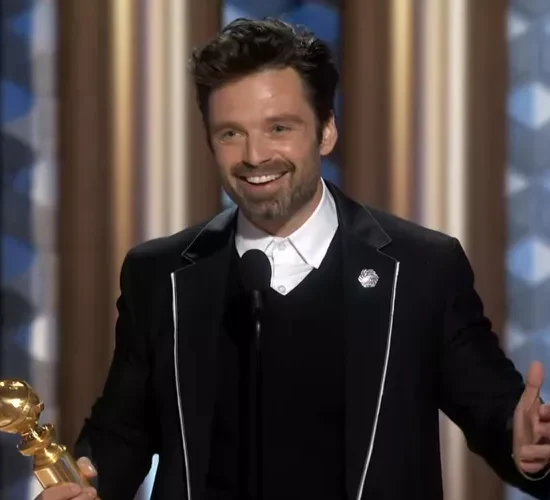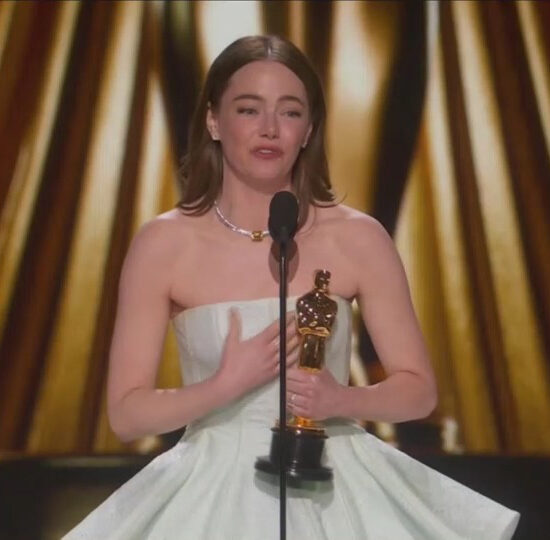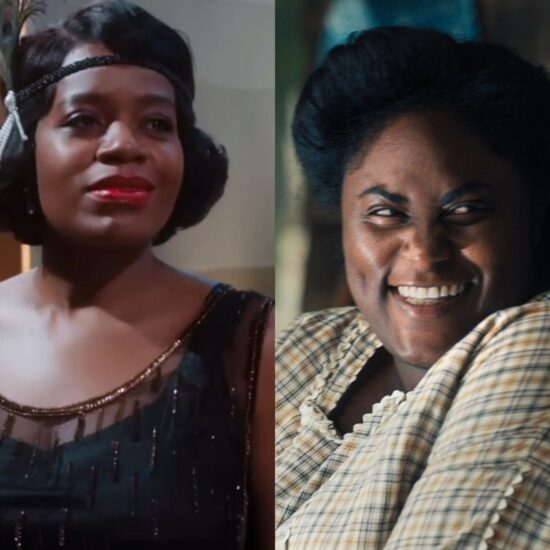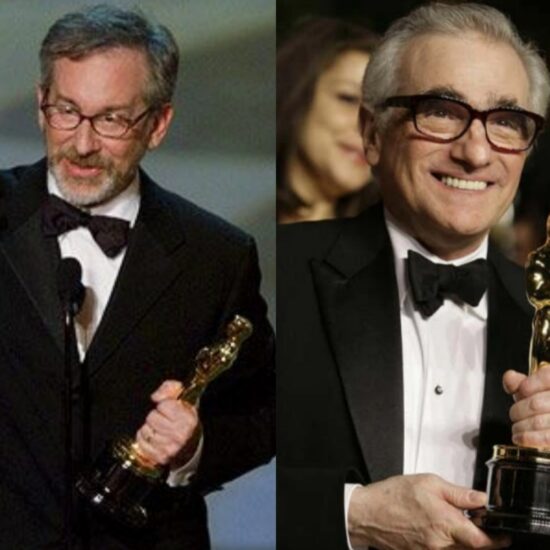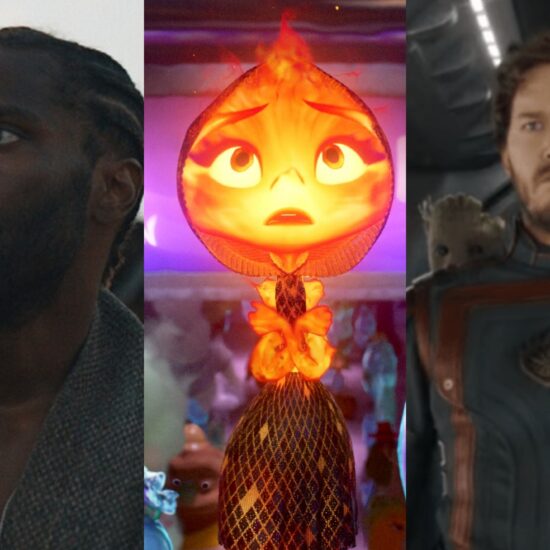
A film about a middle-aged woman undergoing a tax audit should be a relatively simple proposition, unless it’s in the collective hands of the filmmaking duo known as Daniels. Everything Everywhere All at Once is a multiverse movie, but unlike the superhero tentpoles that typically define the concept, this everything-plus-the-kitchen-sink picture — at $100.6 million worldwide, A24’s highest-grossing release ever — was made on a shoestring budget.
“There’s that scene in Apollo 13 where they throw the tools they have on the table and are like, ‘That’s what they’ve got up there, we’ve got to bring them home.’ That’s how we approach filmmaking: ‘We have $14 million, we have all this stuff, how are we going to squeeze it in and make a thing?’ ” says producer Jonathan Wang, who, like many of Daniels’ collaborators, has worked with them since their music video days about a decade ago. “I do think that’s what leads to this emergent creativity that works for us.”
As they wrapped their debut feature, the flatulent-corpse existential buddy pic Swiss Army Man, in 2016, Dan Kwan and Daniel Scheinert began plotting in earnest an equally ambitious follow-up: an exploration of infinite possible realities, grounded in the tale of a laundromat-owning Chinese American family quietly coming apart at the seams. The beleaguered protagonist — a character who had to believably play downtrodden, comedically kickass, genuinely kickass and parental (with all of those infinite variations) — was originally envisioned for Jackie Chan, with Michelle Yeoh in a supporting role as his wife. But when Chan was unavailable, the writer-directors contemplated moving the wife into the spotlight.
“You never know with the alchemy of storytelling how things will fall,” Kwan tells THR. “Swapping the characters made it more personal, which gave us a wealth of experience to imbue into the story. Suddenly it became a lot easier to write and imagine.”
ALLYSON RIGGS/COURTESY OF A24
With that flip of the script, the stars literally aligned. Yeoh said yes. “What I need is to be challenged, to have directors look at me in a different way,” she says. “Over the years, my [characters] have been strong, held together. So when I read the script, I was like, ‘Whoa, what?’ ” By January 2020, production was ready to begin, having finally secured financing and distribution through A24 (the only studio whose tastes are gonzo enough to have taken on Swiss Army Man and come back to Daniels for more) and finalized its cast: Stephanie Hsu as the moody daughter with the power to destroy the multiverse, James Hong as the crotchety grandfather, Ke Huy Quan in the comeback of the century as the sweet beta husband, and Jamie Lee Curtis as the tax auditor from hell (slash frankfurter-fingered love interest).
Fortuitously, the filming of EEAAO took place in the eight weeks immediately before the pandemic hit the U.S. in spring 2020, wrapping — save for two days of pickup — just as everything shut down. The first six weeks shot mainly in an office building in Simi Valley that was previously a Bank of America and a Countrywide Financial before that. “It was literally the people responsible for sinking the economy in 2008 and ’09, the epicenter of all the bad stuff that happened,” says production designer Jason Kisvarday. “So it was actually fun being there, breathing some positive life back into that building for all the terrible things that happened.”

The location already came with cubicles and office drone paraphernalia, but Kisvarday drew from personal experience to add authenticity to what was intended to be an IRS office. “As we were shooting the movie, I actually got audited,” he says. “I brought in copies of my audit paperwork and we peppered it in with the set dressing. I was partially completely devastated but at the same time thought, ‘Wow, this is the real stuff! We need to get this in here.’ “
When it came to realistically cluttering the Wang family’s tiny apartment above their laundromat, set decorator Kelsi Ephraim hired a cultural consultant to take her through L.A.’s Chinatown to procure the right brand of rice steamer and other furnishings, down to the wall calendars distributed by local businesses every Chinese New Year. “That, in addition to our own research, made us feel better that we were doing our due diligence and homework to be culturally sensitive,” says Kisvarday (who got engaged to Ephraim just before production began; the two wed this past October).
The apartment set was built from scratch in the real-life cafeteria of the office building location, which afforded Kisvarday’s team the rare luxury of having time to fine-tune the details while the crew was already gathered there to shoot the IRS scenes. “We had weeks to make that feel as textured as the real-life locations we were shooting in,” he says. “Usually it’s a little too perfect — the light switch is exactly where you expect it to be, not in a strange place, which is what real life normally is. For this one important set we had time to finesse it, come back and add another layer of patina or age.”

ALLYSON RIGGS/COURTESY OF A24
Sets like the IRS office, the apartment and the laundromat required such careful attention to detail, but staging a multiverse’s worth of scenes, some of them glimpsed for only a few seconds, meant being creatively economical. “[Daniels] didn’t want to do everything as greenscreen or composited, fabricated shots,” Kisvarday recalls. “That was the challenge: The quantity of them, in the extremely tight time frame and budget that we had. We were a very well-oiled department and were just showing up and knocking out set after set after set.”
Daniels had detailed the majority of the multiverse settings in their script, so it came down to finding what Kisvarday calls “Swiss Army knife locations,” which could offer many different looks in one place. Chinatown was one, where the crew packed in the various Hong Kong flashback settings within steps of one another. DC Stages in L.A.’s Arts District also proved useful, with its prefabricated free-standing sets (jailhouse, hospital, living room). “They’re OK-looking at a quick glance, which was all we needed them for,” the production designer says. “We were able to shoot maybe 10 different setups in a day, which is normally borderline impossible. And [cinematographer] Larkin [Seiple] is amazing at making anything look incredible.”
If Kisvarday’s EEAAO notebook looked like he was designing for 75 movies all at once, so too did costume designer Shirley Kurata’s racks, which ranged from tax auditor drab to Chinese auntie fashion to the myriad fantastical getups that Hsu’s nihilistic alter-ego antagonist, Jobu Tupaki, sports throughout the film. Just for Jobu and Yeoh’s character, Evelyn, the wardrobe department prepared 31 and 58 looks, respectively — eventually shooting 27 for Jobu, 36 for Evelyn and 11 for Quan’s character, Waymond.

ALLYSON RIGGS/COURTESY OF A24
“Daniels gave me a little Pinterest board of looks they thought were cool, and I also took some inspiration from past sci-fi movies or cool art movies like [Alejandro] Jodorowsky’s The Holy Mountain,” she says. “There were also blogs of Asian moms and grandmas, [the street style project] Chinatown Pretty, and Dan Kwan sent me pictures of his mother and how she dressed. And I would go visit my mom and study her. She has a little vest like what Evelyn was wearing.”
With time and budget essentially the only restrictions facing the craftsmen, they found ways to be even more imaginative. In the IRS hallway where Evelyn first meets Jobu (the Alpha-verse version of her daughter, Joy), the powerful young woman who has unlocked every possibility in every universe is sporting a bedazzled, latter-day Elvis-style jumpsuit, per Daniels’ script. “It would be really expensive to make one from scratch and also time-wise because of the embellishments, so I had to source one that wasn’t even Stephanie’s size,” Kurata says. The script called for Jobu to get shot in that scene, and the costume designer knew she didn’t have the budget for multiple jumpsuits, so she suggested a couple of equally outlandish, more easily reproducible looks that the constantly ‘verse-jumping Jobu could transform into, including a salsa-style outfit and a pro-wrestling leotard. That led to further creativity in the stunt design, with stunt coordinator Timothy Eulich choreographing salsa spins and a gnarly head-scissors takedown to correspond to the new looks.

COURTESY OF SHIRLEY KURATA
With all the costumes she had to procure, Kurata had an average of about $400 to spend per look, “which isn’t much!” she says. “I cut costs on some to allow myself more money for the other looks. Because I shopped in Chinatown for Evelyn and Waymond’s costumes, I was able to use that extra money toward the more elaborate costumes.” Those were mostly Jobu’s outfits, Kurata’s favorite of which was her “Bagel Universe” garb — the stark white ensemble with the Elizabethan collar that Jobu wears when she takes Evelyn to her inner sanctum. “I love that sci-fi cult vibe,” she says of the look, which came together with the help of a custom skirt from fashion designer Claudia Li as well as the collaboration of hair department head Anissa Salazar and makeup department head Michelle Chung, with whom Kurata worked especially closely in creating Jobu’s unforgettable head-to-toe ensembles: “For the Bagel Universe, I knew Anissa had planned this bagel-style braided hair, and I knew there were going to be elements of pearls in her costume, so I said, ‘I’ll get some pearls for you guys that will match, and you can do your magic and integrate that into the hair and makeup.’ “

COURTESY OF SHIRLEY KURATA
Costumes also had to play nice with stunts, as much of the cast’s clothing had to withstand combat scenes. Awards contenders over the years have included elements of action, but EEAAO may have the distinction of being the first to showcase fights involving hot-dog fingers, swinging chihuahuas and sex toys. To choreograph that sensibility, Daniels turned to brothers Andy and Brian Le, a pair of self-taught Hong Kong martial arts movie aficionados on YouTube, for whom EEAAO would be their first major Hollywood gig. “They reached out to us on Facebook Messenger: ‘Hey guys, my name is Daniel Scheinert from Daniels. I swear I’m real, and I’m a director. You want to do our movie?’ ” Brian recounts with a laugh. “They wanted to find guys who had that old-school Hong Kong kung fu style with that blend of a modern wacky twist that suited their style.”
Alongside Eulich, who supervised safety, the Le brothers choreographed all the fights in the film around the main beats — or props — that were scripted. “They were trying to explain the fight scene to us: ‘You’re going to land on this butt plug, and then Andy and Michelle are going to have this Rumble in the Bronx sequence,’ ” says Brian, who also saw action as the other butt-plug fighter in that scene. Adds Andy, “Now it gets fun: How many ways can you get on the butt plug, how many ways can you kick with the butt plug? With all the aerial and flying kicks, having a butt plug hanging out is going to change your aerodynamics, so we had to get creative.”
The Les also incorporated homages to their iconic leading lady. “A lot of friends from our generation know Michelle Yeoh from Crazy Rich Asians and onward, but for us it was her very first films — Yes, Madam!, Supercop. She’s the queen,” Andy, 30, says. (Brian is 29.) “I’m pretty sure I know every kick and punch she’s thrown onscreen. We threw in some Easter eggs.”
![“We pulled [the film] off because we knew [the team] is going to be great,” says Wang (left, with Daniel Scheinert). “We know they’re resourceful and know how to manage their budgets the most, and we all trust each other. Plus, we try to have fun on set, too](https://www.hollywoodreporter.com/wp-content/uploads/2022/11/EEAAO_13032-EMBED-2022.jpg?w=1000)
While the production departments were often hampered by time constraints, the pandemic was a blessing in disguise for those in post. “We were supposed to cut five months or so, but the theaters were closed and the festivals shut down and A24 said, ‘Why don’t y’all just keep working until you feel like it’s done?’ ” says editor Paul Rogers. Ultimately, the team spent about 11 months shaping the film, discarding 40 minutes and entire universes in a massive, delicate balancing act to maintain both emotion and coherence in the story. “The version of the movie that we would have had to send to Toronto would have been fun, but a mess,” says Wang. “The smallest tweaks in a movie this complicated have huge ripple effects.” Explains Rogers, “Because we had changed a scene in act one, the last scene of the movie wouldn’t work all of a sudden. A whole universe we cut was setting up this entire arc later in the film. How do we get that now? It took some creative problem-solving in the editing and some rewriting from Dan and Daniel.”

COURTESY OF SUBJECT
Even with the universes left on the cutting room floor, stuffing in everything that remained resulted in what colorist Alex Bickel estimated was five times more cuts than the average, monoverse film. “We have that montage when Evelyn’s brain breaks and it’s one shot per frame and lasts a minute and a half,” Rogers says. “But what we focused on for most of that year of cutting was making this story connect emotionally.” Those key narrative beats — when to pull in a line of dialogue or a moment from a universe — were, for once, not already dictated in the script. “Dan and Daniel are fantastic editors themselves because they came up where if you want to make a movie and you don’t have any money, you’re doing everything yourself,” Rogers says. “They shot full scenes knowing that we’ll sort it out in the edit. It was kind of like improv jazz: what to call back from earlier, what do we need to see that hits home, what feels right in the moment. That’s what I love about Dan and Daniel’s work. They can take these ingredients that on their own seem silly — butt plugs or whatever — and somehow through this weird alchemy, two rocks falling off a cliff can make you cry.”
As it turns out, what it takes to bring a multiverse to life “is empowerment with resourcefulness,” Wang says. “We were like, ‘It has to be this for 25 percent of it, but the other 75 percent, go crazy.’ That leads to a certain flourishing on set, because you feel supported and loved for your craft.”
This story first appeared in the Nov. 2 issue of The Hollywood Reporter magazine. Click here to subscribe.









